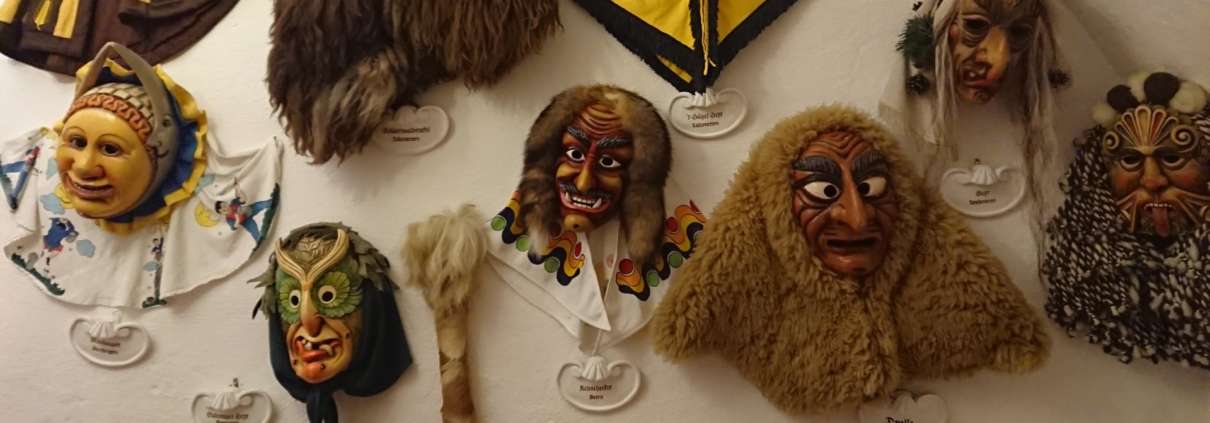Fasnet or Fasching in Stuttgart
Fasnet, Fasching, Karneval – oh my! You may have heard this mysterious holiday described as Germany’s version of Carnival or Mardi Gras, but the photos look more like Halloween! The multiplicity of names for the holiday are determined by geography, regional dialect, and also important historical differences. In this article we aim to help you understand more about the role this holiday has played in various parts of Germany as well as give you specific details about what to look forward to in the Stuttgart region.
Fasnet
People in Baden and Swabia would traditionally have used the name Fasnet or variously Fasent, Fasnacht, Fastnacht, Fassenacht. These are also the names used in the Black Forest, Franconia, Hesse, Mainz, and Saarland. Today Stuttgart is a highly cosmopolitan city, so you’ll hear many names used interchangeably, including Fasching and Karneval as well.
Fasnet has its roots in pagan traditions related to encouraging the end of winter. People donned scary masks of wild men, beasts, and demons and paraded through the streets to frighten away the evil winter spirits. These carved wooden masks and the costumes that go with them are often preserved for generations and can still be seen today in Fasnet parades. Some people trace the name “Fasnet” back to an Old German word “fasen” which meant to be wild and foolish.
As Christianity spread in Germany, the “heathen” traditions were incorporated into the religious calendar. Thus Fasnet came to be celebrated on the eve of the 40-day fasting period that precedes Easter. People used the holiday as a last chance to indulge all kinds of foolishness and pleasure prior to the sober period of the fast. The name “Fastnacht” can be translated as “the eve of the fast.”
Fasching
Fasching has been the name used in Bavaria, Berlin, Brandenburg, and Saxony since the late medieval period. It comes from the Old German word “vaschang,” which signified the last call for serving alcohol before Lent. Particularly in regions that were not swayed by Protestantism, the rules for Lent were observed carefully. In medieval times they were quite strict: only one meal per day which couldn’t include alcohol, dairy, eggs, or meat – a period of teetotaling veganism! Moreover, people were admonished to be reflective and quiet, considering the suffering of Christ.
Thus Fasching was the time to enjoy all the things that were not allowed during Lent. People feasted, danced, sang, paraded through the street in costume, and enjoyed themselves to the fullest. Today’s culture may be far more permissive, but people still enjoy the opportunity to let loose and enjoy a break from the drudgery of winter during Fasching.
Karneval
Karneval is the name used in the Rhineland region, most famously in Cologne. It comes from the Latin name used in the Roman-Catholic church and was carried up from Italy in the 17th century along with many elements of the widely admired Venetian Carnival. The traditions of this region predate the name, however.
In medieval times, this holiday was a time for political satire and turning the feudal order on its head. The common people elected a mock government and selected a prince and princess to govern them. The people mocked the luxurious displays and self-importance of their rulers with funny plays and satirical speeches, but protected themselves from reprisal by wearing masks and costumes to conceal their identity.
In the 18th century, this tradition was modernized to suit the times. The people dressed in costumes similar to military uniforms and formed regiments to mock the occupying French and then the Prussian army. Even today, some Rhinelanders belong to Karnivale regiments and march in parades in powdered wigs!
Dates and Events
The official start of the Fasnet season, also called the fifth season, is “elften elften um elf Uhr elf” – at 11:11 on the 11th of November. This is when the various clubs that put on parades, balls, and other events begin their planning.
In Stuttgart you’ll generally see events related to Fasnet start to appear at the beginning of February. There are costume balls and other parties on the weekends leading up to the most important week of the season: the week before Lent begins. This week falls on different dates each year, since the beginning of Lent is 46 days before Easter, and Easter is calculated according to a lunar calendar.
The celebratory week features outdoor markets with funny contests and games, special children’s programs, and less traditional costume nights in local nightlife venues. The last three days of festivities are known as Tulpensonntag (Tulip Sunday), Rosenmontag (Rose Monday) and Faschingsdienstag (known in English as Shrove Tuesday). There are always parades in various neighborhoods of the city as well as innumerable parties. The Stuttgarter Zeitung always publishes a guide to local events at least a week in advance.
Fasnacht ends as the clock strikes midnight on that final Tuesday, passing into Ashenmittwoch (Ash Wednesday) and the beginning of Lent.

